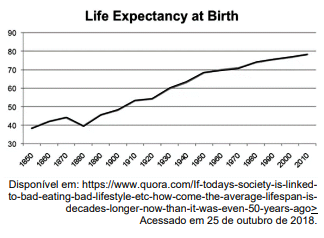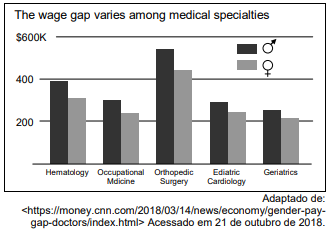Questões de Vestibular
Foram encontradas 68.627 questões
Resolva questões gratuitamente!
Junte-se a mais de 4 milhões de concurseiros!
Read the graph below and answer the following question.

According to the graph above we can assert that
Read the graph below and answer the following question.

According to the graph above it is true to assert that
Read the text below and answer the following question.
Can Cellular Agriculture Feed the World?
Within 20 years, there will be 2 billion more people than today — over 9 billion people in total. The impact to the environment could be severe. Just feeding that population using current methods is problematic.
On average, cattle ranchers need 100 times more land than corn growers to produce a gram of food. So, if that hungry world continues to eat meat like we do, the demand for land — and fresh water — will be alarming, not to mention the environmental impact of raising so many animals. Meat production aside, the large-scale monoculture of crops like corn usually results in damaging terrestrial pollution from pesticides and soil depletion. The impact to the oceans is equally perilous.
Instead of farming animals, fish and plants, cellular agriculture grows the proteins and nutrients we consume from a culture, cell by cell. With this alternative approach, the consumable meat and plant tissues produced don’t need to be harvested from animals or plants. It’s food production on an industrial scale.
The technology to do this is not new. Growing meat from a scaffold embedded in growth culture is no different in theory than making bread from yeast. The vast majority of insulin for diabetics is already manufactured by genetically engineered bacteria, as is the rennet used to culture cheese. In the past 10 years, this approach has been pioneered with a variety of foodstuffs: milk, eggs, beef, chicken, fish — even coffee.
To succeed, cellular agriculture must overcome 6,000 years of established dependence on traditional agriculture, and it has to do so via one of the most finicky human senses: taste. No one will eat manufactured meat or fish if it doesn’t have the same sensual satisfaction generated by the grown version. So, in addition to all the technical challenges in creating edible tissues from cultures, the startups pioneering this approach are working diligently to make their products tasty.
The possibilities for cellular agriculture are seemingly limitless; it may be possible to grow human organs for transplant using the method. But it is still early days.
Adaptado de: <https://earth911.com/business-policy/cellular-agriculture/>
Read the text below and answer the following question.
Can Cellular Agriculture Feed the World?
Within 20 years, there will be 2 billion more people than today — over 9 billion people in total. The impact to the environment could be severe. Just feeding that population using current methods is problematic.
On average, cattle ranchers need 100 times more land than corn growers to produce a gram of food. So, if that hungry world continues to eat meat like we do, the demand for land — and fresh water — will be alarming, not to mention the environmental impact of raising so many animals. Meat production aside, the large-scale monoculture of crops like corn usually results in damaging terrestrial pollution from pesticides and soil depletion. The impact to the oceans is equally perilous.
Instead of farming animals, fish and plants, cellular agriculture grows the proteins and nutrients we consume from a culture, cell by cell. With this alternative approach, the consumable meat and plant tissues produced don’t need to be harvested from animals or plants. It’s food production on an industrial scale.
The technology to do this is not new. Growing meat from a scaffold embedded in growth culture is no different in theory than making bread from yeast. The vast majority of insulin for diabetics is already manufactured by genetically engineered bacteria, as is the rennet used to culture cheese. In the past 10 years, this approach has been pioneered with a variety of foodstuffs: milk, eggs, beef, chicken, fish — even coffee.
To succeed, cellular agriculture must overcome 6,000 years of established dependence on traditional agriculture, and it has to do so via one of the most finicky human senses: taste. No one will eat manufactured meat or fish if it doesn’t have the same sensual satisfaction generated by the grown version. So, in addition to all the technical challenges in creating edible tissues from cultures, the startups pioneering this approach are working diligently to make their products tasty.
The possibilities for cellular agriculture are seemingly limitless; it may be possible to grow human organs for transplant using the method. But it is still early days.
Adaptado de: <https://earth911.com/business-policy/cellular-agriculture/>
Read the text below and answer the following question.
Can Cellular Agriculture Feed the World?
Within 20 years, there will be 2 billion more people than today — over 9 billion people in total. The impact to the environment could be severe. Just feeding that population using current methods is problematic.
On average, cattle ranchers need 100 times more land than corn growers to produce a gram of food. So, if that hungry world continues to eat meat like we do, the demand for land — and fresh water — will be alarming, not to mention the environmental impact of raising so many animals. Meat production aside, the large-scale monoculture of crops like corn usually results in damaging terrestrial pollution from pesticides and soil depletion. The impact to the oceans is equally perilous.
Instead of farming animals, fish and plants, cellular agriculture grows the proteins and nutrients we consume from a culture, cell by cell. With this alternative approach, the consumable meat and plant tissues produced don’t need to be harvested from animals or plants. It’s food production on an industrial scale.
The technology to do this is not new. Growing meat from a scaffold embedded in growth culture is no different in theory than making bread from yeast. The vast majority of insulin for diabetics is already manufactured by genetically engineered bacteria, as is the rennet used to culture cheese. In the past 10 years, this approach has been pioneered with a variety of foodstuffs: milk, eggs, beef, chicken, fish — even coffee.
To succeed, cellular agriculture must overcome 6,000 years of established dependence on traditional agriculture, and it has to do so via one of the most finicky human senses: taste. No one will eat manufactured meat or fish if it doesn’t have the same sensual satisfaction generated by the grown version. So, in addition to all the technical challenges in creating edible tissues from cultures, the startups pioneering this approach are working diligently to make their products tasty.
The possibilities for cellular agriculture are seemingly limitless; it may be possible to grow human organs for transplant using the method. But it is still early days.
Adaptado de: <https://earth911.com/business-policy/cellular-agriculture/>
1) Vidas Secas, de Graciliano Ramos, à volta de personagens, como Fabiano, Sinhá Vitória, os filhos e a cachorra Baleia. 2) O Quinze, de Rachel de Queiroz, que narra o drama da seca de 1915: “o cenário é a caatinga, caracterizada pela seca que devasta a vegetação e o solo, e castiga seus habitantes.” 3) Seara Vermelha, de Jorge Amado, que gira em torno da saga de migrantes nordestinos que fogem da privação provocada pela seca.
Está(ão) correta(s):
1) buscou a valorização da identidade, da história e da cultura nacionais. 2) defendeu a liberdade de criação da obra literária, incorporando temas, vocabulário e sintaxes peculiares aos usos nacionais. 3) cultivou a expressão do cotidiano, optando, assim, na prosa, pelo uso de uma linguagem coloquial e, na poesia, pelo verso livre. 4) na primeira geração de seus autores teve como expoentes Mário de Andrade e Oswaldo de Andrade. 5) na segunda geração, contou com as obras de Manuel Bandeira (Cinza das Horas) e de João Cabral de Melo Neto (Morte e Vida Severina).
Estão corretas:
(Padre Antonio Vieira, Sermão do mandato)
Padre António Vieira é reconhecido como um dos expoentes do período literário conhecido como o Barroco, período:
1) que reflete um momento conturbado da história do continente europeu. 2) caracterizado pelo desequilíbrio entre razão e emoção, pela expressão da dualidade humana. 3) cuja visão conflitante se manifestava pelo uso reiterado de figuras de linguagem, sobretudo de inversões e de antíteses. 4) em que à retórica argumentativa foi atribuída uma função socialmente relevante, como no trecho do sermão mostrado acima.
Estão corretas:

A compreensão dessa peça da publicidade nacional exige atenção para:
1) o caráter homonímico de algumas palavras. 2) o peso do contexto na interpretação das palavras. 3) a polissemia e a possibilidade de ambiguidade de certas expressões.
Estão corretas:
Nós, os brasileiros.
Uma editora europeia me pede que traduza poemas de autores estrangeiros sobre o Brasil.
Como sempre, eles falam da floresta amazônica, uma floresta muito pouco real, aliás. Um bosque poético, com “mulheres de corpos alvíssimos espreitando entre os troncos das árvores e olhos de serpentes hirtas acariciando esses corpos como dedos amorosos”. Não faltam flores azuis, rios cristalinos e tigres mágicos. Traduzo os poemas por dever de ofício, mas com uma secreta – e nunca realizada – vontade de inserir ali um grãozinho de realidade.
Nas minhas idas ao Exterior, onde convivi, sobretudo com escritores, professores e estudantes universitários – portanto, gente razoavelmente culta –, fui invariavelmente surpreendida com a profunda ignorância a respeito de quem, como e o que somos.
– A senhora é brasileira? Comentaram espantados alunos de uma Universidade americana famosa: – Mas a senhora é loira!
Depois de ler, num Congresso de escritores em Amsterdã, um trecho de um de meus romances traduzidos em inglês, ouvi de um senhor, dono de um antiquário famoso, que segurou comovido minhas duas mãos:
– Que maravilha! Nunca imaginei que no Brasil houvesse pessoas cultas!
Pior ainda, no Canadá, alguém exclamou incrédulo:
– Escritora brasileira? Ué, mas no Brasil existem editoras?
A culminância foi a observação de uma crítica berlinense, num artigo sobre um romance meu editado por lá, acrescentando, a alguns elogios, a grave restrição: “porém não parece livro brasileiro, pois não fala nem de plantas, nem de índios, nem de bichos.”
Diante dos três poemas sobre o Brasil, esquisitos para qualquer brasileiro, pensei mais uma vez que esse desconhecimento não se deve apenas à natural alienação estrangeira quanto ao geograficamente fora de seus interesses, mas também é culpa nossa. Pois o que mais exportamos de nós é o exótico e o folclórico.
Em uma feira do livro de Frankfurt, no espaço brasileiro, o que se via eram livros (não muito bem arrumados), muita caipirinha na mesa, e televisões mostrando carnaval, futebol, praias e ... matos.
E eu, mulher essencialmente urbana, escritora das geografias interiores de meus personagens neuróticos, me senti tão deslocada quanto um macaco em uma loja de cristais. Mesmo que tentasse explicar, ninguém acreditaria que eu era tão brasileira quanto qualquer negra de origem africana vendendo acarajé nas ruas de Salvador. Porque o Brasil é tudo isso.
E nem a cor de meu cabelo e olhos, nem meu sobrenome, nem os livros que li na infância, nem o idioma que falei naquele tempo, além do português, me fazem menos nascida e vivida nesta terra de tão surpreendentes misturas: imensa, desaproveitada, instigante e (por que ter medo da palavra?) maravilhosa!
(Lya Luft. Pensar é transgredir. Rio de Janeiro: Record, 2009, p. 49-51)
1) inconformidade; executa seu ofício mas com uma oculta disposição para “inserir ali um grãozinho de realidade”. 2) desilusão; “mesmo se tentasse explicar, ninguém acreditaria que eu era brasileira”. 3) um certo desapontamento: “me senti tão deslocada quanto um macaco em uma loja de cristais”. 4) deslumbramento; “nesta terra de tão surpreendentes misturas!”
Estão corretas as alternativas: